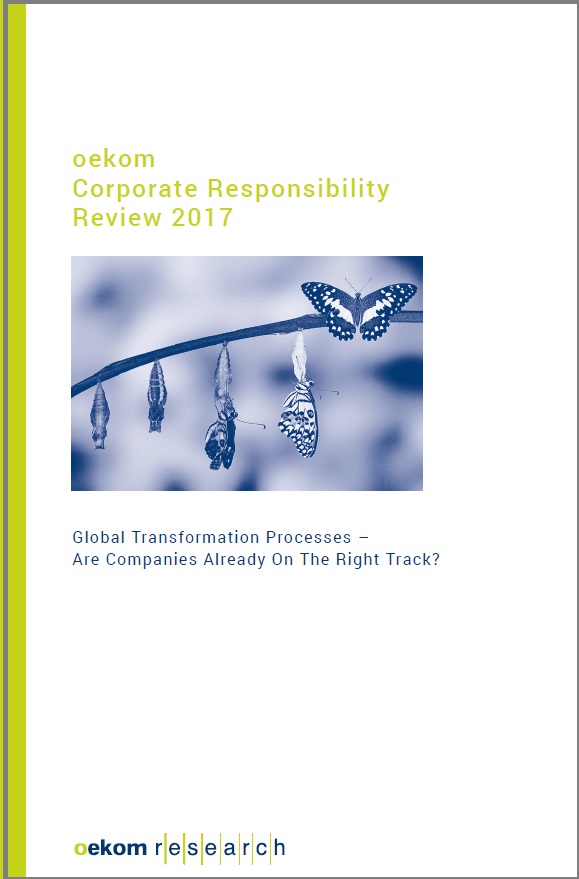Corporate Responsibility Review 2017
Summary of the key results
Development of ESG performance in the oekom Universe
••The share of companies in the GLCU which was awarded oekom Prime status (classification as “good” or “excellent”) rose marginally over the past year, from 16.29 to just over 16.5 per cent. By contrast, the share of companies in the mid-field, with fundamental sustainability management, rose more noticeably, from 35.86 per cent in 2015 to 40.15 per cent today. As in past years, the majority of companies — at 43.31 per cent — continues to exhibit inadequate commitment in the area of sustainability. This distribution is also found at companies in emerging markets: here too, a slight, but continual, positive trend towards better sustainability performance is evident, albeit at a lower absolute overall level.
••On average, none of the sectors is even close to fulfiling the standards which, from the perspective of oekom research’s Best Practices and Best Possible Practices, would be necessary to bring their activities in line with global sustainability goals such as the UN Sustainable Development Goals. In this area, notable climbers over the past year have been the Electronic Components and Semiconductors industries, each of which has risen circa 5 percentage points.
••Large commercial banks have also made aboveaverage gains, where an increasing awareness for sustainability aspects in asset management is emerging in the areas of investment funds and also, at a higher level, in the context of integration and asset overlay strategies. Increasing numbers of banks are also beginning to recognise minimum sustainability standards for project financing — including in countries and regions in which this was not previously commonplace, such as in Asia. In addition to this, the widespread publication of fundamental ESG information has recently risen perceptibly in this traditionally somewhat opaque industry.
••Like last year, the Automobile and Household & Personal Products industries topped the rated industries ranking. Against this background, the even more improved rating of the automobile industry can be exclusively ascribed to the elimination of last year’s worst-faring company, Daihatsu Motor Co Ltd, from the Universe. Like Automobiles, the Household & Personal Products sector is also relatively small and exercises good standards in several central areas without larger negative deviations. Against the generally positive trend, however, the average value has fallen slightly compared to last year — with almost all the industry’s top performers forfeiting large numbers of points.
••This year, too, the most controversial industries with severe and very severe breaches of the principles of the UN Global Compact come from the raw materials segment. Frontrunner is the Oil & Gas Equipment/Services sector, in which six out of every ten companies are affected by controversies. It is followed by Oil, Gas and Consumable Fuels at 47.9 per cent, and Metals & Mining at 39 per cent. Were moderate controversies also to be included for the latter two, the share would rise to 70.4 per cent and 61.0 per cent respectively.
••At 30 per cent, companies in the Oil & Gas Equipment/ Services sector are also frontrunners for involvement in corruption controversies. Like last year, it is followed in second place by the Construction industry at 15.4 per cent of all companies.
••The Textiles sector again leads the rankings for labour rights controversies, even though the value has fallen from 25 per cent to about 20 per cent. By contrast, the share of affected companies in the Electronic Devices & Appliances industry rose noticeably: within the space of a single year, the number of affected companies almost doubled to 13.7 per cent.
••Even if “only” around every tenth company in the most controversial industries is encumbered by a severe controversy in the area of human rights controversies — the list is headed by the Oil, Gas & Consumable Fuels industry at 9.9 per cent — a glance at the moderate controversies highlights that human-rights violations are unequivocally a structural problem in certain industries: with this extended view, for example, the number for the Metals & Mining industry rises from a 7 per cent to almost 25 per cent.
••The industries also exhibit structural problems when looked at from the perspective of environmental controversies. Over 40 per cent of the companies in the Oil, Gas & Consumable Fuels sector are embroiled in such controversies, and as well as a solid 34 per cent in the Metals & Mining sector. If moderate controversies are also included, the shares rise to 67 per cent and almost 50 per cent respectively.
To download the full report, please click here.
